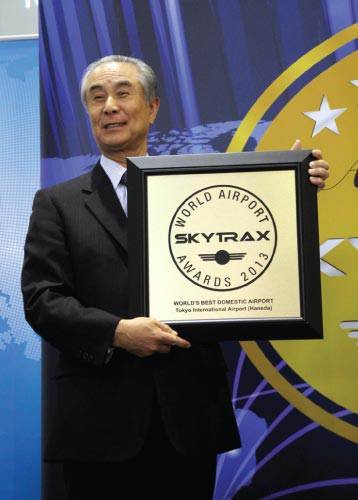Sixty years since it was formed to develop the old Haneda Airfield into the Tokyo International Airport, the Japan Airport Terminal Co. Ltd. (JAT) has overseen the construction and management of passenger terminals in one of the world’s most important financial centers. (Currently, JAT operates one international and two domestic terminals.)

In what is clear recognition of JAT’s efficient management, Haneda Airport was named the Best Domestic Airport in Skytrax’s World Airport Awards this year. Located in central Tokyo, Haneda has also been recognized by Forbes Traveler as the most punctual airport in the world for two straight years.
“We consider ourselves to be a highly functional airport, and we will maintain that. But we would like to go beyond functionality. We want the people who visit Haneda Airport to be happy and comfortable. We are also constantly looking for ways to be the ideal place in terms of commercial facilities,” said JAT President Isao Takashiro.
Although JAT is recognized as a pioneer in the field of airport operation and widely known for its expertise in terminal management, the company is also responsible for other aspects of the airport’s business: retail establishments, restaurants, building operations, facilities management, parking lot operations, and in-flight catering.
“We also look into opportunities beyond the scope of the airport. In China, for example, we have a business alliance with Beijing Airport. We also have maintained a business alliance with Gimpo International Airport in Korea for the past ten years that has involved a constant exchange of information and human resources,” said Takashiro.
“We are looking to establish more alliances to share and expand our know-how. In fact, we have received inquiries from a number of countries in Southeast Asia that are interested to have us work with them in airport construction and management. These are the opportunities we are looking into,” he added.
Apart from opportunities abroad, JAT is considering an unexpected move into the higher–education sector. With the University Hub Haneda Airport (UHHA) Project, JAT hopes to capitalize on its position as a transportation hub to be a focal point for exchange of knowledge and information.
“We see ourselves as a central base, not just for air traffic. Haneda Airport can also function as a hub for a variety of things: commercial operations, Japanese culture, and even education. With our UHHA project, we wish to cultivate Japanese youth and promote interest in other countries and cultures. In turn, we hope promote Japanese culture to foreign people,” Takashiro explains.
Over the past few years, the Japanese aviation industry has seen a lot of changes with the steady growth of the tourism sector in Japan, the rise in the number of low–cost carriers, and the adoption of the “open skies” policy.
“Airline companies are working hard to be more efficient and constantly incorporate new measures into their operations. To accommodate these developments, we need to make changes in our system, too. We work on keeping down costs and improving the services we provide, so that we stay ahead of the others,” says Takashiro.
“We are currently building an extension to the international terminal, which will be completed in 2014. So by next year, we will double the number of daytime flights per year to 60,000,” he added.
With its round-the-clock operations and location in Tokyo proper, Haneda provides passengers with two major advantages, which JAT capitalizes on in its objective to become a major regional and international airport.
JAT’s message is simple. “We hope that many people from all over the world will come to Japan. And we hope their pleasant experience will begin and end with Haneda Airport,” Takashiro stressed.
– This Special Report on Japan originally appeared in the July/August 2013 edition of Foreign Affairs (Credit: Janine Ramirez)

